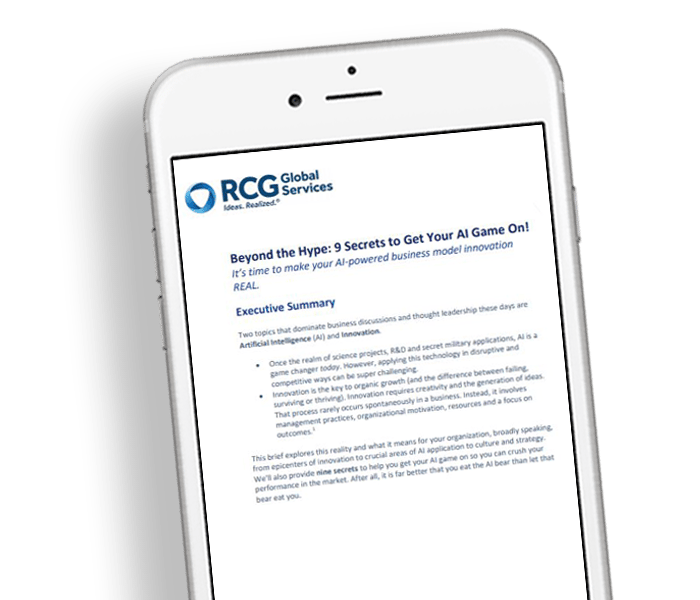Beyond the Hype: 9 Secrets to Get Your AI Game On!
The race to adopt and implement AI in business processes has already begun. But the successful application of AI requires that your organizational culture fosters innovation and change. Are you ready to drive the ideas needed to win in the marketplace?
AI and Digital Transformation: More than a novelty to your firm

We all encounter AI every day in some form or another. So, in this fantastic era of digital transformation, one of the most significant technological innovations changing everything around us is, in fact, AI, which provides measurable business outcomes when it is supported by the right cognitive technologies and innovative applications. We use AI every day. It’s not only on your smartphones, laptops and cars; it’s everywhere.
As electricity did over 100 years ago, the growing range of artificial intelligence technologies is rewriting rules and enabling (if not driving) business, industries and society to transform in such a way that every part of our world is changing. With that being said, from a business and revenue perspective, we are still in the early days. However, that is changing quickly. The future of AI promises, and is delivering, a new era of disruption and productivity. A new world is emerging where human ingenuity is augmented by the speed and precision of computer intelligence. For a business, this translates to a whole new paradigm and business model.
Indeed, AI, coupled with machine learning, has been a growing technology for more than a decade and has been around for even longer. However, the advancement in computer power, availability of data and connectivity of devices, along with recent media coverage and hype, have drawn more attention to artificial intelligence (AI) technologies today. The number of new AI consulting companies and AI-focused start-ups is exploding. From chatbots to facial recognition, AI provides direct, measurable business benefits and outcomes. AI enables organizations to work smarter, take the friction out of process and engagement and make better decisions.
For perspective, consider:
- There have been over 154,000 AI patents filed worldwide since 2010.2
- There has been a steady uptick in the patent category covering AI, machine learning and neural networks.3
- Between 2013 and 2018, the category of AI patents grew by 34% annually and we won’t even get into all the venture investments and start-ups because it is difficult to follow.4
Studies show that AI could boost profitability by an average of 38%.5 That’s a big uptick for companies faced with fierce competition and increasingly saturated markets. However, according to McKinsey, so far only about 20 percent of AI-aware companies are currently using one or more of AI technologies in a core business process or at scale.6
Also consider that:
- Two-thirds of the opportunities to use AI are in improving the performance of existing analytics use cases.
- On average, AI techniques have the potential to provide a boost in additional value above and beyond traditional analytics techniques ranging from 30 percent to 128 percent, depending on industry.
- When priorities of use cases with AI benefits are mapped against complexity, 54% of firms have not even begun to address what is in their must-do quadrant (those opportunities plotted against complexity and benefit that rank high on benefit and low complexity).7
Every industry wants AI, and virtually all industries are using AI at this point with varying degrees of advancement and success. A quick view of the rapid explosion of sectors engaged in deep-learning with chip-maker NVDIA® since 2013 illustrates this point with only 100 to more than 3,409 just three years later.8
While industries vary as to their use-case priorities for AI, predictive analytics is an overall key priority together with real-time operations management. These priorities make sense since implementing AI and cognitive solutions are already having, and will continue to have, a significant impact on industry and organizational innovation and efficiency. Intelligent systems can automate an enormous amount of your work, help reduce the risk of human errors, and make engagement processes smoother, better, and more productive. As time goes by, your systems will learn and get smarter resulting in better business outcomes.
Innovate and transform—or die. Really!

Certainly, AI’s impact on both marketing and innovation must not be underestimated. The reality is that virtually all industry sectors are pursuing cognitive solutions and being disrupted at a faster and faster pace. The net effect is that it forces all types of businesses to become transformers—like it or not. Or, they’ll go the way of Raphus cucullatus, more commonly known as the flightless Dodo bird.
While many organizations are or are becoming “AI Aware” which typically entails exploring new solutions, running proof of concepts or implementing AI as part of vendor solutions, few firms have driven AI and cognitive technology solutions to scale.
Is that truly a problem? On the one hand, that is just where we are on the technology adoption curve. However, things are heating up, and the time is now to get your “AI game on.” The real problem lies in that many businesses are not realizing and acting with a sense of organizational urgency and focused on the innovation and transformation needed to deal with the practical significance and scope of how AI will drive innovation and disruption.
AI IS disruptive. So, there will be winners and losers.
Successful application of AI requires an organizational culture that can foster innovation and change as well as a nimble market-orientation. Remember the old saying that culture eats strategy for lunch? Well, how fast can you make sure your organization’s processes, culture, and structure can support the speed of innovation needed? That process of strategic change does not happen overnight.
The rise of the robots also means the rise of the transformers.

In the sci-fi world, being a transformer is not always a noble calling. In a series of favorite comics and films, it was the evil “decepticons” who deployed transformation technology in a bid to dominate the universe.11 Business executives may feel similarly under siege by forces beyond their control. They may feel completely overwhelmed by the concept of AI and what to do or where to even start. Market, competitive, regulatory, and other disintermediating forces and pressures have forced many organizations to the brink.
So, what about transformation? It is a holistic, long-term change program that stands in sharp contrast to conventional approaches. It goes beyond the level of first-order change (incremental alteration of an existing process), where many organizations get stuck, to enable the second and third orders of change in which methods and structures are fundamentally reconfigured to drive and support new organizational behaviors—and to become capable of continuous change as events require.
Transformers do exist, and they accomplish strategic orientation for innovation—adaptation winning through culture change—not just technology and business model innovation. They are led by strong guiding coalitions, typically composed of stakeholders who recognize the enormity of the threat to the organization’s survival if change does not occur. These individuals understand the operational requirements and lengthy return horizon when implementing transformative strategies. Their support empowers the transformers to do the “heavy lifting” required to overcome cultural barriers and the roadblocks presented by a rapidly changing environment.
AI means culture matters more than ever. Ignore it at your peril.

Inability to change and adapt is where many organizations get tripped up.
Knowing how culture and strategy affect one another, transformers insist on organization-wide involvement (top to bottom) and a leadership structure that enables people to produce good results. The guiding coalition creates a sense of urgency and cultural change, followed by behavioral change over time. Transformers focus on the basics of organizational culture to create a workplace that empowers rather than blocks, facilitates change, and creates an engaged, responsible, and loyal staff committed to customer satisfaction. Such a culture depends on highly effective operating systems and infrastructure, followed with discipline and rigor. Transformers are skilled at staying ahead of competitors and staying in touch with their markets, communities, and customers in their decision-making and relationships. They have strong cross-functional and system capabilities and thinking.
However, we are just talking about AI. And that’s the point. AI is only technology. Application is innovation. Innovation is based on culture. You must manage culture as part of your success in the new world of intelligent everything.
If worrying about culture isn’t enough, there are plenty of other challenges that should cause a sense of urgency about AI.
Stop worrying, start moving!
Executives value the quality of an AI solution and its ability to drive ROI, customer satisfaction, and contribution to strategic goals. The demand for intelligent business processes is growing across verticals to enhance the overall experience that is delivered to their customers as well is improve engagement, operations, and insight for decision-making. Accordingly, organizations are focusing on integrating AI capabilities with their existing business applications. Many verticals are currently focused on the adoption of readily available AI-powered APIs and machine learning models to solve their business problems. However, the process of identifying and building APIs is time-consuming. It can be difficult for a firm to keep pace with the technology and solution marketplace, which is highly fragmented and shifting.
It should be no surprise then that the race to adopt and implement AI in business processes has already begun. Research indicates that more than 27% of organizations say they have already incorporated the technology into critical processes and services, while another 46% have one or more AI pilot projects underway.12
Organizations keep hitting headwinds, getting stuck and even scrapping programs and restarting. Despite their optimism, businesses recognize several significant obstacles to leveraging AI successfully.
Enterprises struggle with AI adoption. These strategic obstacles include:
- Lack of an AI strategy
- Lack of awareness about AI capabilities
- Lack of AI talent in their organizations
- Lack of understanding of how to put it all together effectively
- Challenges with obtaining data sets
- Technical difficulties with advanced AI techniques like deep learning
Business leaders like you value both the quality of an AI solution (its performance) as well as its ability to drive ROI, customer satisfaction, and contribution to strategic goals. However, many business and technology leaders aren’t sure where to start. Besides, AI projects can be slow and expensive to implement. There is much risk in pursuing AI. Further, the AI and machine learning landscape is complex and fragmented, not even considering the variety of user tech, data science, and analytics-related software and solutions on the market.
Executives are feeling the challenge. When asked, they see some significant risks regarding the adoption of and increasing the use of AI.13
AI is like a match to gasoline regarding the business model Innovation Imperative.

The truth is that the market puts a premium on innovations that are both radical and also competence-destroying change.12 Firms can take advantage of technological change that may be either competence enhancing or “competence destroying” to experience a significant positive impact on commercial success.14
How disruptive is disruptive? Well, any change to a critical element of your business model is disruptive. However, AI and cognitive technologies are unleashing new ideas and applications that are changing multiple components and patterns of current business models—fundamentally changing how a business creates, communicates, and delivers value. Truly transformative business model innovations affect numerous parts of the nine main building blocks: Revenue, Cost, Customer Segments, Value Propositions, Customer Relationships, Key Activities, Key Resources, Distribution Channels, and Key Partnerships.15
There are generally four critical epicenters for business model innovation:
- Resource-driven: Originate from an organization’s existing infrastructure or partnerships to expand or transform the business model.
- Offer-driven: Create new value propositions that affect other business model blocks.
- Customer-driven: Innovation based on customer needs, facilitated access, or increased convenience, and they affect other business model components.
- Finance-driven: Driven by new revenue streams, pricing mechanisms, or reduced cost structures that affect other areas of the business model.16
Also, some innovations are driven across multiple-epicenters of a business model. AI innovations are occurring across these critical dimensions:
- Product: New and improved offers.
- Efficiency: Faster, better, automated, and cheaper processes, workflows and engagement.
- Insight: Unique, better insight, prediction and decision-making.
9 secrets to getting your AI game on.

- AI should not be ignored.
Implementation of AI and cognitive technologies to achieve performance transformation and competitive advantage is no longer an option. All companies need to be doing this in a way that makes sense for their business model. Don’t put your head in the sand and don’t fall behind! Realize this now and mobilize accordingly. Start to understand what this means for your business. - Get an AI strategy and activation plan.
The best efforts will make innovation a priority. Create an AI strategy and activation plan that prioritizes opportunities and use cases focusing on time to value and results. Creating, communicating, and delivering value is the purpose of a business model, and AI will be pervasive. This strategy and plan need to include culture and technology considerations, as well as the business model perspective, and all of the epicenters of innovation to achieve operations efficiency and better insight and decision-making. Your business strategy should consider your business (and your industry model) as well as the potential priorities and opportunities across the epicenters of innovation. It should also discuss innovations to enable better offers/product, efficiency, and better insight and decision-making. - Now is the time to be asking lots of “What If” questions.
Remember that this is a time of disruption, not incrementalism. Don’t hold back your thinking with the status quo. You should challenge conventional assumptions with “what if” questions. These questions help us break free of our constrained thinking imposed by our current business models. We should be disturbed by compelling, difficult-to-execute propositions. These are starting points.16 - Change management is key.
It is important to note that AI is different from traditional software. Unlike Big Data, where you could buy a new capability, AI depends on scientific insight, more profound organizational process changes, and even culture change. Culture change is a strategic program. - Get the right fit and right science for adoption and success.
Deep technology and real data science will enable better results as compared to canned or vendor-specific solution. Creating solutions that leverage the optimal technologies and approach tailor-fit to the use case will increase value and adoption. - It is not just about shiny objects. Don’t throw out useful techniques just for the sake of AI.
AI isn’t always the best answer for specific use cases where more traditional methods may be. There are often significant trade-offs and future considerations. Other times, AI can drastically improve performance. In-depth knowledge of both data science and data engineering are essential to smart solutions. Technology will continue to change at a fast pace. - Consider the big picture.
Ethics, societal, legal, and regulatory considerations are essential as they relate to AI data. Consider these issues as crucial factors in any business model or plan. Dedicate white space and time for meaningful dialogue on these matters. - Avoid the perils and costs of trial-and-error and pilot purgatory.
A business that is interested in pursuing severe transformation can benefit from choosing a known programmatic approach that delivers results rather than trying to find its way through painful trial and error. Having the right partner and model in bringing drive innovation and bring transformation to life is a critical success factor, especially in these challenging times. - Seize the day.
- Take that first small step or next step
- Let go of the past and welcome the future
- Move now
- Fix your priorities and work on your culture and strategic orientation to truly connect with the market through innovation and transformation
- Get help
At RCG, we see our role as helping organizations like yours embrace the cognitive era with innovation in a way that is smarter, faster, and achieves outcomes that matter while reducing risks. We are here to help make it all REAL.
Download a PDF version of this guide by filling out this form


